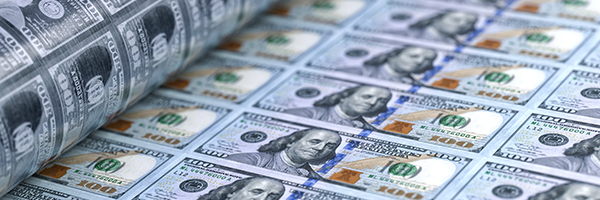Friday Trick or Trend

May 16, 2021 | Daily JAM, Friday Trick or Trend |
On Friday, May 14, stocks continued their bounce from the drop in the early part of the week. The Standard & Poor’s 500, for example, gained 1.49% on the day. The technology heavy NASDAq Composite climbed 2.32%. The BIG TECH heavy NASDAQ 100 gained 2.17%. The small cap Russell 2000 picked up 2.47%. Tech stocks rebounded strongly with Apple (AAPL) up 1.98% on the day; Amazon (AMZN) ahead 1.94%; Microsoft (MSFT) higher by 2.11%; and Alphabet (GOOG) gaining 2.40%. But tech stocks weren’t the biggest winners.

May 7, 2021 | Daily JAM, Friday Trick or Trend |
Just in case you need a reminder after a year when the economy slid and slid and the stock market soared and soared, the stock market isn’t the economy. And today’s weak jobs number raises some troubling questions about the speed of the post-vaccine economic recovery. I’d say that today’s jobs report raises three big questions about the economic recovery.

April 30, 2021 | AAPL, Daily JAM, Friday Trick or Trend, Jubak Picks, Top 50 Stocks, WH |
When it comes down to company earnings, we’re seeing a huge lag in revenue growth for companies in the service sector. Wyndham Hotels and Resorts (WH),for example, which reported first quarter results today, April 30, saw revenue fall to $303 million in the first quarter of 2021 from $410 in the first quarter of 2020. But, and I think this is the clear implication of the first quarter GDP numbers, those service companies will close that gap in the June quarter as companies open more services–Disney (DIS) opened its California theme parks today, for example–and consumers feel safer in going to theme parks or restaurants or gyms.

April 24, 2021 | Daily JAM, Friday Trick or Trend |
It may seen illogical but the time to buy Call Options betting on a better than expected earnings report from Company A, B or C, is well before (two weeks? 10 days?) the earnings report date and the time to sell is before the earnings report itself. The price of an Call Option is likely to fall on the earnings report date even if the company delivers the positive surprise you were hoping for

April 17, 2021 | Daily JAM, DIS, Friday Trick or Trend |
Can you say “Pent up demand?” Theme parks in California began reopening this month of the first time in more than a year. Restrictions limit visitors to state residents and the parks are allowed to operate at just 25% of capacity. And they’re selling out.

April 11, 2021 | Daily JAM, Friday Trick or Trend, Long Term, Volatility, You Might Have Missed |
Based on existing analyst forecasts for earnings in all of 2021, the S&P 500 trades at almost 24 times estimates, among its highest valuations ever. To bring the multiple down to its long-term average of 16 times annual profits, companies in the gauge will have to make about 15% more than the equity researchers currently expect them to earn — in 2023.

April 2, 2021 | Daily JAM, Friday Trick or Trend |
The Consumer Financial Protection Bureau is warning of a deluge of foreclosures that could hit the housing market in September. As of January more than 2 million borrowers had either postpone their mortgage payments or failed to make them for at least three months, according to the bureau. Government-authorized forbearance plans begin to end in September. That means hundreds of thousands of home owners will need help getting back on track or face foreclosure on their homes.

March 27, 2021 | Daily JAM, Friday Trick or Trend, Jubak Picks, Top 50 Stocks |
Car makers have put investors on notice that a severe shortage of chips is forcing them to curtail production. Volkswagen, Toyota, and General Motors have all reported halting production due to a shortage of silicon and the companies have suspended forecasts of manufacturing volumes because of the shortage. Volkswagen, for example expects a drop in production of 100,000 cars in the first quarter. Electric car maker Nio has suspended production at its Chinese plant for 5 days due to the shortage. And the shortage looks to be getting worse.

March 20, 2021 | Daily JAM, Dividend Income, Friday Trick or Trend, Jubak Picks, Long Term |
In commodities world there are bounces. There are rallies. And then there are super cycles of higher prices that can go on for years on an imbalance between supply and demand. We’re had our bounce in copper. And our rally. Now are we seeing the emergence of a copper super cycle? I think the answer is yes.

March 12, 2021 | Daily JAM, Friday Trick or Trend, Mid Term |
The iShares 20+ Year Treasury Bond ETF (TLT) fell 2.12% at the close today to drop into a Bear Market having lost more than 20% from its August high. That’s just in case you needed a reminder of how relentless the selling in the Treasury market has been. At the close at $136.06, the ETF is below the both the 50-day and 200-day moving average. And the Treasury bond ETF is down 13.74% year to date as of the close on March 12. Treasury bonds, even long-dated Treasury bonds aren’t supposed to produce that kind of volatility. Which leads me to the important question: How long does this rout go on and what are the odds of a short-term bounce?

March 7, 2021 | Daily JAM, Friday Trick or Trend |
Cash flows for emerging market stocks turned negative in the last week of February, according to the Institute for International Finance. Cash flows for emerging market debt turned negative last week. The data show daily outflows of $290 million in the last week. That compares to daily inflows of about $325 million in February.
February 21, 2021 | Daily JAM, Friday Trick or Trend |
Simple rules of supply and demand say that plans by the Biden administration for a $1.9 trillion package of coronavirus stimulus/relief and proposals to spend another $2 trillion on infrastructure should be driving up yields on government bonds (and driving down prices.) Investors want more reward–higher yields–in return for buying more Treasuries and taking on the risk that all this supply will push Treasury prices lower. But the bond market is hardly ever as simple as it looks and there are other trends at work that you ought to figure into your investment calculations.













